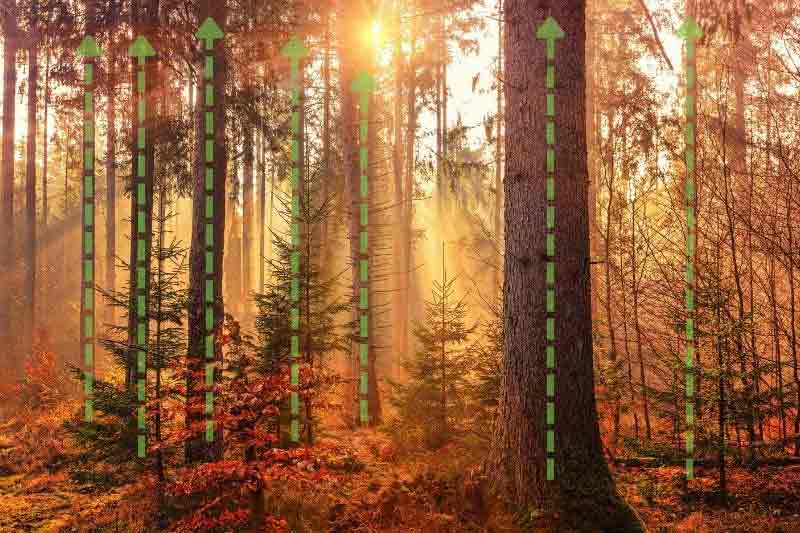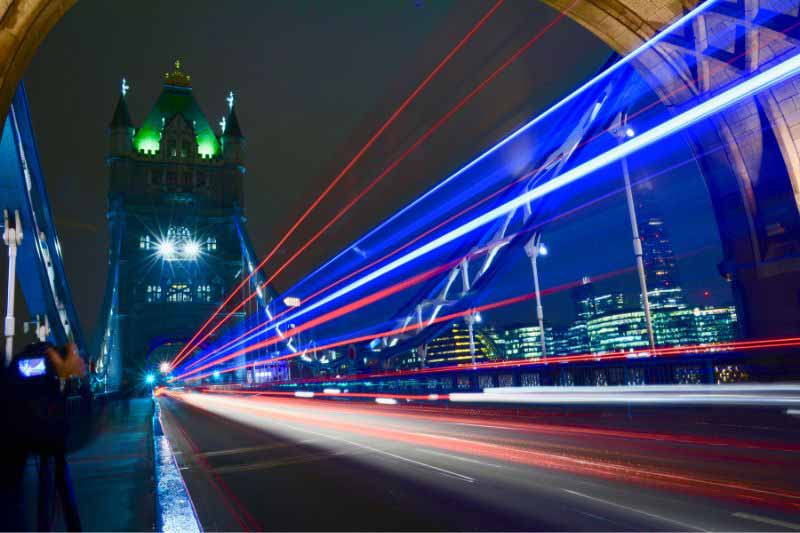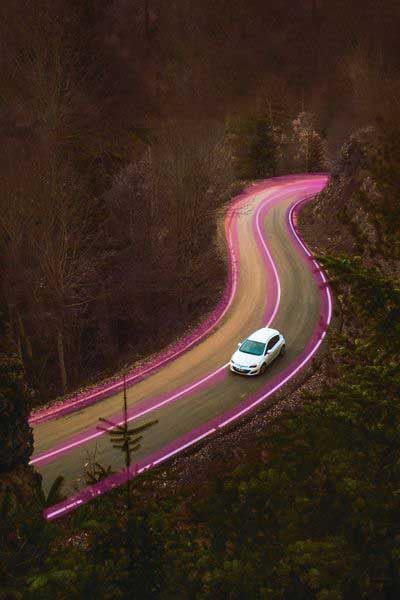9 Types of Lines in Photography Composition+How to Use It?
You can compose an image in different ways using different elements of photography. Lines in photography are one such element that you can use for composition. If you use it in the right way, you can create stunning images. You need to know how to make a proper arrangement of lines in the scene to capture a beautiful image. In this guide, I will show you how to use lines in photography composition.
I will also share the 9 types of lines that you can use in your image. It will give you a better idea of how to use each of these lines for your scene.
What are Lines in Photography Composition?

You can use the lines in the scene to compose your picture. There are two ways of using lines.
One way is to use the lines alone in the frame. The other way is to use it along with other subjects or elements in the frame.
The choice between the two needs to be decided by the photographer. It mainly depends on the scene and the type of photography you want to capture.
All the lines in the scene may not be actual lines; some can be implied lines too. Therefore, in order to use the lines in photography composition, you need to develop the photographer’s eye to find both actual and implied lines.
9 Types of Lines in Photography Composition
In a scene, there can be different types of lines. So, as a photographer, you need to have a good understanding of all the types of lines that you will encounter in the scene.
It will help you to compose your shot in a better way that is aesthetically pleasing for everyone. I will show you how to use 9 types of lines in photography compositions.
1. Leading Lines

One of the commonly used lines in photography composition is the use of leading lines. It is an easy-to-use technique to compose an image.
As the name suggests, the lines in the scene will lead to the main subject in the frame. Thus, it will be easy to draw the viewer’s attention to the subject.
If you see the above image of the lady in the boat. The two sides of the boat act as the leading lines pointing toward the lady, which is the main subject in the frame. Thus, the viewer’s eye is directed toward the lady.
Consider reading this in-depth guide on leading lines photo composition techniques to know more.
2. Diagonal Lines

You can also make use of diagonal lines in photography composition. You can make the picture look more dynamic with the help of diagonal lines.
Diagonals help to create an illusion of depth in the scene. In addition, it helps to bring more than one dimension to an image.
If you are interested in bringing the tension into the frame, the best way is to use diagonals. Many famous photographers use this technique.
But if there are too many diagonal lines in the scene, you will not get the desired impact with your image.
Also, ensure that the diagonal line does not go across the two opposite corners of an image. It will divide the image exactly into two equal triangles. Thus, it makes the image less interesting. Try to avoid it when you capture it on camera.
3. Horizontal Lines

The horizontal lines in an image show stability. It is because the human eye will go through the image from left to right.
So, when there are horizontal lines in the picture. Then, it will be easy to direct our eyes to the subject without distractions.
Unlike diagonal lines, there won’t be any tension in the image composed using this technique.
You might have already heard about horizon line in photography. It is a perfect example of using horizontal lines in photography. This horizon will be mostly the line of separation between the water body and the sky.
You can capture the horizontal lines in the scene perfectly using your camera. Just turn on the rule of grids feature in the camera. Then, align one of the grid lines with one of the horizontal lines in the scene and capture the image.
In the above image, the subject of interest is the “Red and Grey Car.” The viewer’s attention is drawn to this subject with the help of the yellow horizontal lines on the road.
Now you know how to use horizontal lines in photography composition.
4. Vertical Lines

Vertical lines are less effective when compared to diagonal ones. People who do forest photography commonly make use of this image composition technique to capture the trees in the forest. You can also use it to photograph tall skyscraper buildings or architecture.
Here, the thing is, there will not be any interesting things that grab the attention of the viewer. But the photographer can make it more interesting if he can capture it with sun or sun rays.
If you see the above image composed using vertical lines, you can see the different trees. So, your eyes will go from bottom to up without any interesting element in the scene.
From my experience, vertical lines are more appealing to the user if you capture the scene in portrait orientation than in landscape.
If you want to capture perfect vertical lines in the camera, turn ON the grid feature.
5. Curved Lines

Another popular type of line that you may come across is curved lines. It can be curved roads, rails, lakes, pathways, etc.
It takes some practice to compose images using curved lines. However, curves do help to create a sense of depth in the image.
You can use the curve to direct the viewer’s attention to the subject. Also, curves help to convey a sense of calmness in the image when compared to straight lines.
In the above birds eye view image, you can see how the curved road draws the viewer’s eye to the red car.
6. Converging Lines

Many photographers, especially portrait photographers, use converging lines to compose their pictures. The convergence brings a completely new perspective and depth to the image.
Here, you need to keep your main subject at the converging point of different lines in the scene.
So, it is quite easy to apply this rule for portrait shots since you can ask your subject to stand at the converging point. But in the case of other types of photography, you can use it only when your main subject comes in this position.
A converging point can come in different ways.
- It can be due to the different Diagonal lines in the scene.
- It can be due to Horizontal and Vertical lines.
- Diagonal lines converging with Horizontal or Vertical lines.
- Curves alone.
- It can also be curved, converging with Diagonal, Horizontal or Vertical lines.
In the above image, the light trails captured using the long exposure photography technique leads to the other end of the bridge with the beautiful building.
Here, the building is the main subject. The light trails in red and blue are the converging lines converging at the other end of the bridge.
7. Parallel Lines

You can also use parallel lines in the scene to compose your shot. The parallel lines can be horizontal, vertical, diagonal, or curves.
The parallel lines in the scene will appear to go on forever. Thus, it brings an entirely new perspective to the image. It takes the viewer’s eye to a distance.
When the parallel lines are perpendicular to the axis of the camera lens, it can lead you to infinity.
You can try to place your subject in any of the parallel lines in the scene.
If you look at the above image, the subject of interest is the “Person Driving the Yellow Scooter.” The viewer’s attention is drawn to this subject with the help of the yellow parallel lines on the road.
8. Implied Lines

The term Implied means “suggested but not directly expressed.” So, here you will be unable to find an explicit line in the scene. Instead, it will be an imaginary line created by arranging a series of elements.
Some commonly seen implied lines in photography include a series of trees, pillars, lamp posts, etc. As a photographer, you need to look around and see if you can make a composition with the help of the implied lines created by such elements in the frame.
In the image above, there are no explicit lines. However, if you observe closely, you can see the imaginary lines created by the series of pillars on either side. It directs the viewer to the portion of the wall on the other side.
9. S Curves

Another popular line in a composition is the S curve. If you have an S-shaped path, rail, or roadway in the scene, you can use it as a guideline for the subject.
The curve need not be an exact S shape. It can be an inverted S or a mirrored S also.
Thus, you can easily draw the viewer’s eye to the subject. Sometimes, the S shape in the scene act as a scene divider. It is true in the case of aerial mages photographed using drones.
People who do flat lay photography also make use of the S curve. There will be multiple elements arranged on a flat surface. These elements will be arranged in an S-shaped pattern.
If you look at the above picture, the S-shaped bend on the road is used as the guiding line toward the car.
Using Multiple Types of Lines in a Single Image

Sometimes, you may get the opportunity to use different types of lines in photography composition. It can really help to create a powerful image.
But you must ensure harmony between the lines used in the scene for composition. Otherwise, it will be total chaos.
In the above image, you can see the “Building” at the center is the main subject. Here, different types of lines draw the viewer’s attention to the subject.
The building is on the horizontal horizon line (red dotted arrows).
The S-shaped river leads into the building (green lines).
The diagonal line (white line) is created by the separation of the lake and land on the right-side, pointing towards the building.
The other side of the right-side lake points to the building with the help of the curved line.
Thus, this image is a good example where multiple lines are used in the composition.

